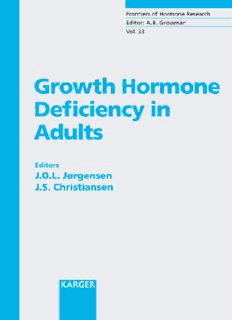
Growth Hormone Deficiency in Adults (Frontiers of Hormone Research) PDF
Preview Growth Hormone Deficiency in Adults (Frontiers of Hormone Research)
Growth Hormone Deficiency in Adults Frontiers of Hormone Research Vol.33 Series Editor Ashley B. Grossman London Growth Hormone Deficiency in Adults Volume Editors Jens Otto Lunde Jørgensen Aarhus Jens Sandahl Christiansen Aarhus 14 figures and 13 tables, 2005 Basel·Freiburg·Paris·London·New York· Bangalore·Bangkok·Singapore·Tokyo·Sydney Jens Otto Lunde Jørgensen,MD Medical Department M Aarhus University Hospital Aarhus, Denmark Jens Sandahl Christiansen,MD Medical Department M Aarhus University Hospital Aarhus, Denmark Library of Congress Cataloging-in-Publication Data Growth hormone deficiency in adults / volume editors, Jens Otto Lunde Jorgensen, Jens Sandahl Christiansen. p. ; cm. – (Frontiers of hormone research, ISSN 0301-3073; v. 33) Includes bibliographical references and index. ISBN 3–8055–7992–6 (hard cover : alk. paper) 1. Dwarfism, Pituitary. 2. Somatotropin–Therapeutic use. 3. Growth disorders. [DNLM:1. Human Growth Hormone–deficiency–Adult. 2. Human Growth Hormone–therapeutic use–Adult. 3. Hormone Replacement Therapy–Adult. 4. Hypopituitarism–complications–Adult. 5. Hypopituitarism–etiology–Adult. 6. Hypopituitarism–therapy–Adult. WK 550 G88398 2005] I. Jørgensen, Jens O. L. II. Christiansen, Jens Sandahl. III. Series. RC658.7.G77 2005 616.4(cid:1)7–dc22 2005018888 Bibliographic Indices. This publication is listed in bibliographic services. Drug Dosage. The authors and the publisher have exerted every effort to ensure that drug selection and dosage set forth in this text are in accord with current recommendations and practice at the time of publication. However, in view of ongoing research, changes in government regulations, and the constant flow of information relating to drug therapy and drug reactions, the reader is urged to check the package insert for each drug for any change in indications and dosage and for added warnings and precautions. This is particularly important when the recommended agent is a new and/or infrequently employed drug. All rights reserved. No part of this publication may be translated into other languages, reproduced or utilized in any form or by any means electronic or mechanical, including photocopying, recording, microcopying, or by any information storage and retrieval system, without permission in writing from the publisher. © Copyright 2005 by S. Karger AG, P.O. Box, CH–4009 Basel (Switzerland) www.karger.com Printed in Switzerland on acid-free paper by Reinhardt Druck, Basel ISSN 0301–3073 ISBN 3–8055–7992–6 Contents VII Foreword Grossman, A.B. (London) IX Preface Jørgensen, J.O.L.; Christiansen, J.S. (Aarhus) 1 Clinical Aspects of Growth Hormone Deficiency in Adults.An Overview Jørgensen, J.O.L.; Christiansen, J.S. (Aarhus) 21 Epidemiology of Adult Growth Hormone Deficiency.Prevalence,Incidence, Mortality and Morbidity Erfurth, E.M. (Lund) 33 Hypopituitarism following Traumatic Brain Injury Popovic, V. (Belgrade); Aimaretti, G. (Turin); Casanueva, F.F. (Santiago de Compostela); Ghigo, E. ( Turin) 45 IGF-I Measurements.Epidemiological and Clinical Aspects Juul, A. (Copenhagen) 68 Diagnosis of Growth Hormone Deficiency Fisker, S. (Aarhus); Andersen, M. (Odense); Ørskov, H. (Aarhus) 86 Clinical Monitoring of Growth Hormone Replacement in Adults Gibney, J. (Dublin); Johannsson, G. (Gothenburg) V 103 Consequences of Growth Hormone Deficiency for Intermediary Metabolism and Effects of Replacement Nørrelund, H. (Aarhus) 121 Skeletal and Cardiac Muscle in Adults with Growth Hormone Deficiency Cuneo, R.C.; Wallace, J.D. (Brisbane) 146 Bone Metabolism and Growth Hormone Deficiency.Experimental and Clinical Aspects Ueland, T.; Bollerslev, J. (Oslo) 161 Growth Hormone and Fluid Homeostasis Møller, J. (Aarhus) 185 Growth Hormone and Body Composition Mersebach, H.; Feldt-Rasmussen, U. (Copenhagen) 196 Effects of Growth Hormone Deficiency and Growth Hormone Treatment on Quality of Life in Growth Hormone-Deficient Adults Arwert, L.I.; Deijen, J.B.; Drent, M.L. (Amsterdam) 209 Safety Aspects of Growth Hormone Replacement Waterhouse, M.; Monson, J.P. (London) 222 Author Index 223 Subject Index Contents VI Foreword Just over 20 years ago, I published a paper into the effects of radiotherapy on pituitary tumors, and noted that the only major endocrinopathy that occurred early was growth hormone deficiency: I dismissed this finding as ‘this was of no clinical relevance since the patients were adult’ [Br Med J 1984;288: 110–1109]. How things have changed since then. Not only is the syndrome of adult-onset growth hormone deficiency (AGHD) now well recognized and described in detail, but thousands of adult patients throughout the world are being treated with synthetic growth hormone on a regular basis. Much of the early work on describing the syndrome originated in Europe, and the editors of this volume have been at the forefront in this area from its inception. It now seems appropriate at this point to draw breath, and assess exactly what is the current status of AGHD, what are its defining clinical and biochemical features, what are the risks and benefits of treatment, and what progress is likely in the future. The editors of this volume have brought together a superb group of inter- national experts in this area, and I am sure that this will become an essential sourcebook for all practicing endocrinologists who take care of patients with adult-onset growth hormone deficiency. Ashley B. Grossman, London VII Preface Growth hormone (GH) is essential for longitudinal growth and it has been known for more than 40 years that GH-deficient children benefit from replace- ment with the hormone. Based on experimental studies and Nature’s own exper- iment with acromegaly it is, however, an even older observation that GH has important biological actions in adults. In 1989, it was demonstrated that GH deficiency in hypopituitary adults was associated with distinct abnormalities, which could be reversed by GH replacement, and since 1994 this treatment modality has been a licensed indication in most countries. Controversies do, however, remain within this field and novel data continue to emerge. This book provides an update on some of the pending issues. It encom- passes the traditional end points of GH therapy such as body composition, bone biology and physical performance. Attention is also devoted to diagnostic aspects and side effects. Additional features range from clinical epidemiology to quality of life, and novel areas such as the impact of traumatic brain injury on pituitary function are also covered. The contributions stem from recognized clinicians and scientists, who have been working in the field for decades. Jens Otto Lunde Jørgensen, Aarhus Jens Sandahl Christiansen, Aarhus IX
Description: